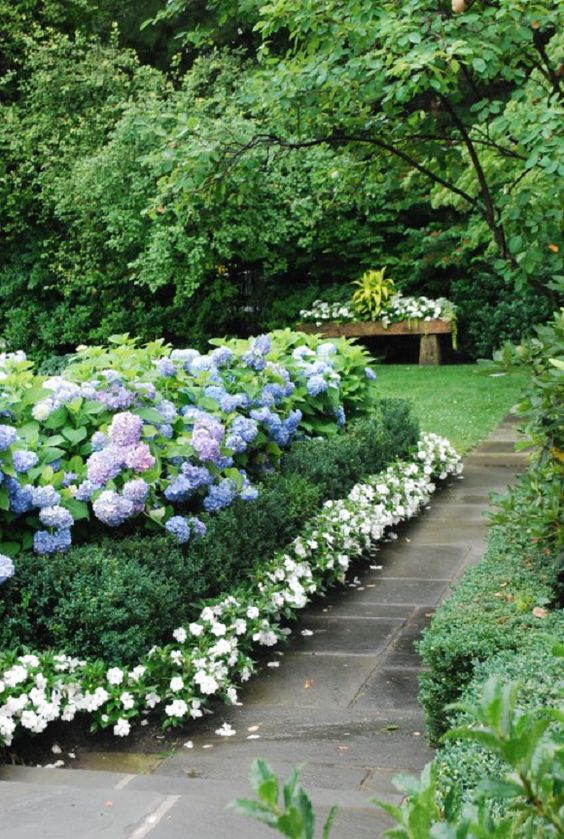I miss all kinds of things about growing plants in the Southeast and in New England, but probably the biggest loss for me is the giant, blue bombs of color in summer you get from a mophead hydrangea. Sure, you can grow mophead hydrangeas in Iowa, but their flowers will be pink. I love that blue so much it’s worth it to me, even as the lowest of low-maintenance gardeners, to do a little work to get my hydrangeas blue. Here are three easy steps for you to make sure your hydrangeas bloom blue all summer long.
01. CHOOSE THE RIGHT TYPE
Step one is to choose the right plant. Many hydrangeas bloom pink, cream, or white, but only a few will bloom blue. I adore oakleaf hydrangeas and ‘Limelight’ hydrangea, but you’ll never see a bright blue flower on those. Mophead and lacecap hydrangeas are the only ones that bloom blue (that’s Hydrangea macrophylla and her hybrids.) Once you have a mophead, select plants that are bred to go blue.
‘Endless Summer’ hydrangeas are about the only ones hardy enough for Iowa’s winters that will bloom blue. There are many plants in the ‘Endless Summer’ line, so check the label – they are churning out some crazy color combinations, and if you want the true blue, stick with The Original Endless Summer hydrangea. That plant is my standby for big blue bombs of color. ‘Nikko Blue’ is another option, but it’s only hardy to zone 5 and blooms only on old wood – meaning, if you get a bad spring frost and the flower buds get zapped, you won’t have flowers at all that season. ‘Endless Summer’ blooms on both old and new wood, so you’ll get flowers whether there’s a frost or not. Out at our acreage, my Endless Summer hydrangeas died back just about to the ground this past miserable winter, and they’re already blooming this year.
‘Twist and Shout’ is another hardy blue-bloomer, but it’s a lacecap, not a true mophead. Lacecap hydrangeas have little tiny flowers surrounded by larger ones, instead of just one big ball of color. They make more of a mess as cut flowers, but they do provide something for pollinators to eat, which the mopheads don’t. So select a plant that is actually able to bloom blue, is bred for bright blue color, AND is tough enough for your climate.
02. KNOW YOUR pH
Pink or blue hydrangea flowers depend on what’s going on in the soil. Mophead hydrangeas bloom pink in alkaline soil and blue in acidic soils, so you need to get that pH down below 7 – ideally 5.5 and lower for a true blue. Here in Iowa, you’re pretty much guaranteed that your soil is not acidic enough for blue flowers without some help. It’s worth doing a very simple pH test that you can pick up at any hardware store or garden center- at the very least, it’s fun science to do with your kiddos.
03. ADJUST pH ACCORDINGLY
The good news is that there are super easy ways to change the pH around your hydrangeas without becoming a soil scientist. Some people will DIY it with coffee grounds, sprinkling them around the base of their plants. This may not change the soil enough to get the pH down low for a deep blue flower color, and you’ll have to apply often as the coffee grounds break down. There’s likely no harm done, though, so feel free to sprinkle away. Compost is also typically acidic, so adding compost around your shrubs may help too. And if your compost is mostly coffee grounds, like ours is- even better!
You can also purchase straight up aluminum sulfate like a real farmer. You have to mix it with water and apply often- it is so soluble it will wash out of the soil. But you also need to be careful not to apply too much, as it can be toxic to plants at high levels. I don’t go this route, even though I’m married to an Iowa farm boy. It’s too much measuring and monitoring for me.
I stick with soil acidifiers like Holly-tone. Bailey’s makes one also, with blue hydrangea flowers right on the label. Soil acidifiers are available at every hardware store and garden center near the fertilizer. Use their instructions and included scoop, and the work is done for you. Pay attention to how much you need to reapply, so that your blue blooms stay around all season. And seriously, read the package instructions so you don’t harm any surrounding plants.
Mulching with pine straw or pine bark is also a good idea even if you use one of the other options – hydrangeas like moist, rich soil, so a good mulch cover will keep them happy – and the pine straw or pine bark will lower the soil pH as it breaks down.
Being from the East coast, a blue hydrangea is an emblem of summertime for me. Moving to the Heartland means I have to work a little bit harder, but it’s worth it for these glorious flowers in my yard.


LIke it
pin it
tweet it
email it